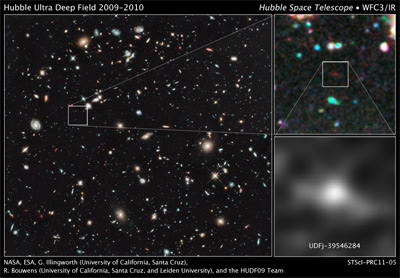Special delivery! See our visiting baby yaks (Dec. 20–Jan. 5) this holiday. Learn more
Science News
Most Distant Galaxy
January 31, 2011

The Hubble Space Telescope once again proves itself a heck of a time machine. How does it see back in time? Because light travels at a finite speed (fast, after all, but not infinitely fast): the farther away you look, the farther back in time you see.
UC Santa Cruz researchers, using Hubble’s powerful Wide Field Planetary Camera 3, have looked 13.2 billion years into the past, discovering a small, compact galaxy of blue stars that existed only 480 million years after the Big Bang.
Creatively named UDFj-39546284, it ranks as the most distant galaxy yet observed. And it is pretty small by galaxy standards—over one hundred such mini-galaxies would fit inside our Milky Way.
Although individual stars can’t be resolved by Hubble, evidence suggests that this is a compact galaxy of hot stars that first started to form 100 to 200 million years earlier in a pocket of dark matter.
How do scientists find these distant, infant galaxies? According to Universe Today,
Astronomers gauge the distance of an object from its redshift, a measure of how much the expansion of space has stretched the light from an object to longer (“redder”) wavelengths.
Nature published the paper describing UDFj-39546284 last week. But astronomers calculate a 20% chance that the distant light is not a galaxy. It will take the pricey James Webb Telescope to confirm its galactic standing. Webb’s infrared vision should provide spectroscopic measurements that can confirm the tremendous distance of the reported object. For now, UDFj-39546284 will have to wait—the telescope won’t launch for at least another three years. But heck, what’s three years compared to 13.2 billion?
Image credit: NASA, ESA, G. Illingworth (University of California, Santa Cruz), R. Bouwens (University of California, Santa Cruz, and Leiden University), and the HUDF09 Team